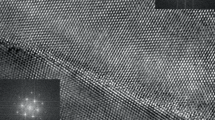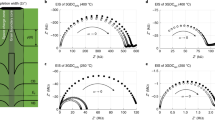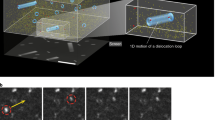Abstract
The trapping of electrons by grain boundaries in semiconducting and insulating materials is important for a wide range of physical problems, for example, relating to: electroceramic materials1 with applications as sensors, varistors2 and fuel cells, reliability issues for solar cell3 and semiconductor technologies4,5 and electromagnetic seismic phenomena in the Earth’s crust6. Surprisingly, considering their relevance for applications7 and abundance in the environment, there have been few experimental or theoretical studies of the electron trapping properties of grain boundaries in highly ionic materials such as the alkaline earth metal oxides and alkali halides. Here we demonstrate, by first-principles calculations on MgO, LiF and NaCl, a qualitatively new type of electron trapping at grain boundaries. This trapping is associated with the negative electron affinity of these materials8 and is unusual as the electron is confined in the empty space inside the dislocation cores.
This is a preview of subscription content, access via your institution
Access options
Subscribe to this journal
Receive 12 print issues and online access
$259.00 per year
only $21.58 per issue
Buy this article
- Purchase on Springer Link
- Instant access to full article PDF
Prices may be subject to local taxes which are calculated during checkout



Similar content being viewed by others
References
Waser, R. & Hagenbeck, R. Grain boundaries in dielectric and mixed-conducting ceramics. Acta Mater. 48, 797–825 (2000).
Clarke, D. R. Varistor ceramics. J. Am. Ceram. Soc. 82, 485–502 (1999).
Yan, Y., Noufi, R. & Al-Jassim, M. M. Grain-boundary physics in polycrystalline CuInSe2 revisited: Experiment and theory. Phys. Rev. Lett. 96, 205501 (2006).
Seto, J. Y. W. The electrical properties of polycrystalline silicon films. J. Appl. Phys. 46, 5247–5254 (1975).
Walker, P. M., Mizuta, H., Uno, S., Furuta, Y. & Hasko, D. G. Improved off-current and subthreshold slope in aggressively scaled poly-Si TFTs with a single grain boundary in the channel. Electron Devices IEEE Trans. 51, 212–219 (2004).
Takeuchi, A., Nagahamab, H. & Hashimotoa, T. Surface electrification of rocks and charge trapping centers. Phys. Chem. Earth A/B/C 29, 359–366 (2004).
Vink, T. J., Balkenende, A. R., Verbeek, R. G. F. A., van Hal, H. A. M. & de Zwart, S. T. Materials with a high secondary-electron yield for use in plasma displays. Appl. Phys. Lett. 80, 2216–2218 (2002).
Rohlfing, M., Wang, N.-P., Krüger, P. & Pollmann, J. Image states and excitons at insulator surfaces with negative electron affinity. Phys. Rev. Lett. 91, 256802 (2003).
Kohyama, M. Computational studies of grain boundaries in covalent materials. Modelling Simul. Mater. Sci. Eng. 10, R31 (2002).
Dawson, I. et al. First-principles study of a tilt grain boundary in rutile. Phys. Rev. B 54, 13727–13733 (1996).
von Alfthan, S., Haynes, P. D., Kaski, K. & Sutton, A. P. Are the structures of twist grain boundaries in silicon ordered at 0 K? Phys. Rev. Lett. 96, 055505 (2006).
Clarke, D. R. Grain boundaries in polycrystalline ceramics. Annu. Rev. Mater. Sci. 17, 57–74 (1987).
Kizuka, T., Iijima, M. & Tanaka, N. Atomic process of electron-irradiation-induced grain boundary migration in a MgO tilt boundary. Phil. Mag. A 77, 413–422 (1998).
Yan, Y. et al. Impurity-induced structural transformation of a MgO grain boundary. Phys. Rev. Lett. 81, 3675–3678 (1998).
Duffy, D. M. Grain boundaries in ionic crystals. J. Phys. C 19, 4393–4412 (1986).
Watson, G. W., Kelsey, E. T., de Leeuw, N. H., Harris, D. J. & Parker, S. C. Atomistic simulation of dislocations, surfaces and interfaces in MgO. J. Chem. Soc. Faraday Trans. 92, 433–438 (1996).
Harding, J. H., Harris, D. J. & Parker, S. C. Computer simulation of general grain boundaries in rocksalt oxides. Phys. Rev. B 60, 2740–2746 (1999).
Parkin, S. S. P. et al. Giant tunnelling magnetoresistance at room temperature with MgO (100) tunnel barriers. Nature Mater. 3, 862–867 (2004).
McKenna, K. P., Sushko, P. V. & Shluger, A. L. Inside powders: A theoretical model of interfaces between MgO nanocrystallites. J. Am. Chem. Soc. 129, 8600–8608 (2007).
Benia, H.-M., Myrach, P. & Nilius, N. Photon emission spectroscopy of thin MgO films with the STM: From a tip-mediated to an intrinsic emission characteristic. New J. Phys. 10, 013010 (2008).
Sushko, P. V., Shluger, A. L., Hirano, M. & Hosono, H. From insulator to electride: A theoretical model of nanoporous oxide 12CaO·7Al2O3 . J. Am. Chem. Soc. 129, 942–951 (2007).
Stevenson, J. R. & Hensley, E. B. Thermionic and photoelectric emission from magnesium oxide. J. Appl. Phys. 32, 166 (1961).
Tsukazaki, A. et al. Quantum Hall effect in polar oxide heterostructures. Science 315, 1388–1391 (2007).
Mather, P. G., Read, J. C. & Buhrman, R. A. Disorder, defects, and band gaps in ultrathin (001) MgO tunnel barrier layers. Phys. Rev. B 73, 205412 (2006).
Barth, C. & Henry, C. R. Kelvin probe force microscopy on surfaces of UHV cleaved ionic crystals. Nanotechnology 17, S155S161 (2006).
Sato, Y. et al. Atomic and electronic structure of symmetric tilt grain boundary in ZnO bicrystal with linear current–voltage characteristic. J. Mater. Sci. 40, 3059–3066 (2005).
Perdew, J. P. & Wang, Y. Accurate and simple analytic representation of the electron–gas correlation energy. Phys. Rev. B 45, 13244–13249 (1992).
Kresse, G. & Joubert, J. From ultrasoft pseudopotentials to the projector augmented-wave method. Phys. Rev. B 59, 1758–1775 (1999).
Eby, J. E., Teegarden, K. J. & Dutton, D. B. Ultraviolet absorption of alkali halides. Phys. Rev. 116, 1099–1105 (1959).
Lapiano-Smith, D. A., Eklund, E. A., Himpsel, F. J. & Terminello, L. J. Epitaxy of LiF on Ge(100). Appl. Phys. Lett. 59, 2174–2176 (1991).
Acknowledgements
Computer time on HPCx was provided through EPSRC grant EP/D504872/1. We acknowledge useful discussions with P. Sushko, M. Stoneham and G. Besurker. K.P.M. is supported by EPSRC grant GR/S80080/01.
Author information
Authors and Affiliations
Corresponding author
Rights and permissions
About this article
Cite this article
McKenna, K., Shluger, A. Electron-trapping polycrystalline materials with negative electron affinity. Nature Mater 7, 859–862 (2008). https://doi.org/10.1038/nmat2289
Received:
Accepted:
Published:
Issue Date:
DOI: https://doi.org/10.1038/nmat2289
This article is cited by
-
Ladderphane copolymers for high-temperature capacitive energy storage
Nature (2023)
-
High-performance a-IGZO-based flexible TTFT with stacked dielectric layers via ultrathin high-κ SrTiO3 buffer layer grown on HfO2
Journal of Materials Science: Materials in Electronics (2022)
-
Accurate atomic electron affinities calculated by using anionic Gaussian basis sets
Theoretical Chemistry Accounts (2020)
-
Ceramic phases with one-dimensional long-range order
Nature Materials (2019)
-
Atomic structure and electronic properties of MgO grain boundaries in tunnelling magnetoresistive devices
Scientific Reports (2017)



